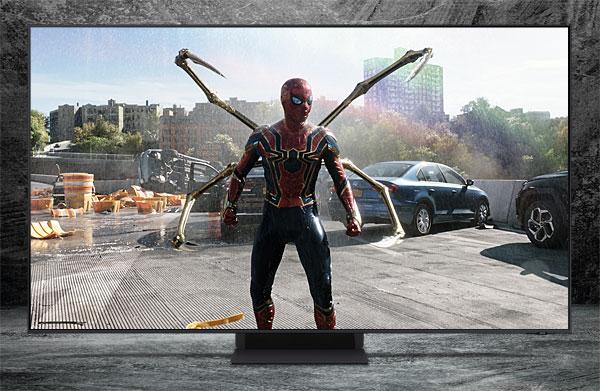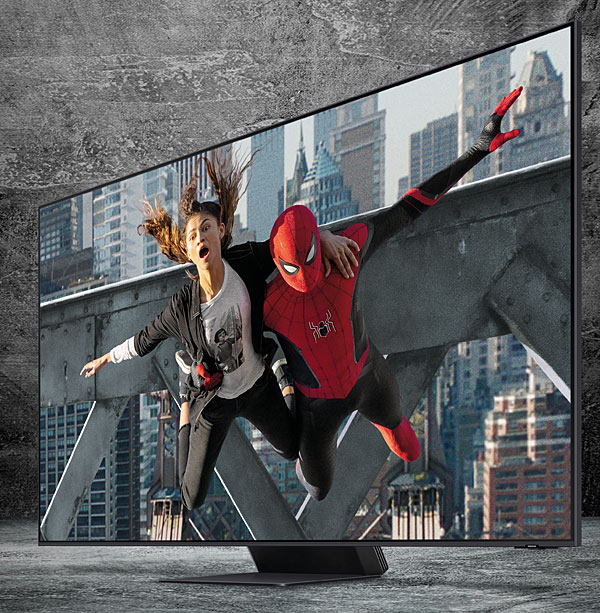Samsung QE65QN95B 65in 4K HDR LED TV Review

 Samsung's first new TV of 2022 emphasises the strengths of mini LED technology, reckons John Archer
Samsung's first new TV of 2022 emphasises the strengths of mini LED technology, reckons John Archer
While OLED had new brighter panels to shout about in 2021, the story of the year for rival LCD technology was definitely the arrival of mini LED backlighting. Samsung, in particular, showed how moving to much smaller LEDs, coupled with an increase in a TV's number of local dimming zones, could rewrite the LCD picture quality rule book in terms of contrast precision. Now it returns with a second-gen model to hopefully wow us again.
The first major new TV release of 2022, the QE65QN95B (which is available at 85in, 75in and 55in sizes, plus the 65in model tested here) bristles with on-paper promise. Its mini LED lighting system works in conjunction with 720 separately controlled dimming zones, and it's bright too: rated by Samsung at 2,000 nits, but capable of pumping out a measured light output peak on a 10 per cent HDR window of more than 2,800 nits. By comparison, the punchiest of OLED TVs still barely sneak past 1,000 nits.
Adapting To The Challenge
The number of dimming zones is actually the same as last year's QN95A mini LED 4K predecessor (reviewed in HCC #319). Samsung has, however, refined the process by which each zone manages its light, via a new technology it dubs Shape Adaptive Light Control. This, says the brand, gives each dimming zone more freedom to manipulate the shape of the light it produces. A single zone could, for example, deliver more brightness to an object that may sit towards its centre, but gradually 'fade' the brightness down at its edges should the area around the central object be relatively dark. This is a way to further counter the backlight 'bloom' that can affect an LED-lit flatscreen.

Meanwhile, Samsung's not-at-all-scary neural networks have been busy over the past 12 months, with the 65QN95B's picture quality now benefiting from the combined expertise of 20 AI systems, versus 16 previously.
Also likely to boost picture quality is a shift from the 12-bit processing of the 2021 models to 14-bit. This has the potential to reduce colour banding or blocking problems with HDR material, in addition to delivering more greyscale information (likely resulting in greater detail in dark areas).
For the 65QN95B's audio, Samsung has also made upgrades. Dolby Atmos decoding has finally been added (although this new relationship with Dolby hasn't extended to Dolby Vision HDR support), as have upfiring units to the set's Object Tracking Sound (OTS+) system that ranges speaker drivers all around the TV's bodywork in an effort to place sound effects more accurately.
Another upgrade fits into the thinking that gaming performance is a key attraction of a premium TV. All four of the 65QN95B's HDMI inputs can play 4K content at 120Hz (in fact, the frame rate support extends to 144Hz), and support variable refresh rates, automatic low latency mode switching, and the AMD FreeSync Premium Pro and Nvidia G-Sync VRR formats.
Samsung has also tried to make gaming easier to optimise via its Game Dashboard, which presents related information and settings within a streamlined menu.
Tizen Goes Large
Rounding out the 65QN95B's tweaks for 2022 is an overhaul of the Tizen smart hub, moving from yesteryear's use of a home menu superimposed over a small part of the screen to a fullscreen interface. This hosts content shelves that try to bring together material from a wide range of different providers. And I have issues with it.

First, too much space on the home screen is taken up by a massive ad box. Second, the attempt to pull in content from all over the place just results in a bombardment of rubbish. Third, you can't reorder the shelf running order to better suit your interests. And lastly, the relationship between the TV's setup menus and smart content menus can be bizarrely inscrutable.
Samsung's good voice recognition support bails the system out somewhat, but it's going to take a lot of work to make the new interface likeable for 2023. Unless Samsung just goes back to the previous perfectly good one...
Bustin' Makes Me Feel Good
These smart interface woes are forgiven (if not entirely forgotten) once you lock eyes on the 65QN95B's imperious pictures. Lingering half thoughts that the Shape Adaptive Light Control feature might be a gimmick are emphatically dispelled, as it soon becomes obvious that this set is able to produce images that are simultaneously more dynamic and more refined than they were on last year's QN95As.
During the spectacular light show of the climactic face-off at the end of Ghostbusters: Afterlife (4K Blu-ray), the darkness of the night sky looks even more consistently rich and deep black than it does on a QN95A. There's also even less interference from clouding and blooming around the intense lights cast off by the Ghostbusters' 'beams' and sparking electricity generator. In fact, I struggled to see any blooming issues at all, even with the action paused during any of the most extreme contrast moments of the fight.
The Shape Adaptive Light Control also has a huge impact on the 65QN95B's outstanding gaming abilities, removing all traces of the sometimes quite pronounced blooming that HDR games, such as Assassin's Creed: Valhalla, can cause. Note that gaming is also aided by a much more effective/enjoyable take on AMD's FreeSync Premium Pro than we got last year, plus an input lag figure that reaches as low as 10.4ms, which can be considered best-of-breed.
 |
Home Cinema Choice #351 is on sale now, featuring: Samsung S95D flagship OLED TV; Ascendo loudspeakers; Pioneer VSA-LX805 AV receiver; UST projector roundup; 2024’s summer movies; Conan 4K; and more
|

















































